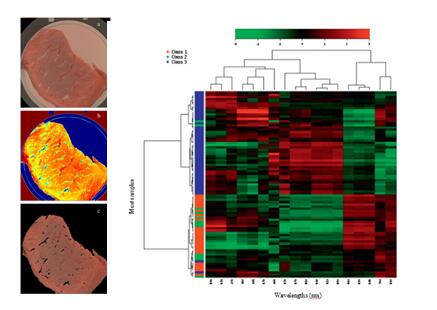品质至上,客户至上,您的满意就是我们的目标
技术文章
当前位置: 首页 > 技术文章
多光谱成像快速无损监测肉品品质领域应用
发表时间:2017-01-18 13:25:53点击:2228
来源:博普特
分享:
Potential of multispectral imaging technology for rapid and
non-destructive determination of the microbiological quality of beef
filets during aerobic storage

在不同温度条件下(0, 4, 8, 12和16 °C)监控无氧包装肉片腐烂实验中,我们对多光谱成像系统(Videometer Lab)的性能进行了评估。从肉样表面采集了可见光和短波近红外区域(405–970 nm)的光谱数据以及相关的微生物学数据(对数计数),包括总生菌数(TVCs),假单胞菌属(Pseudomonas spp.)和热死环丝菌Brochothrix thermosphacta.)。基于总生菌落数,我们采用了质量定性分析法(PLS-DA) 来区分在3个微生物质量级别的肉样,分别为Class 1 (TVC b 5.5 log10 CFU/g), Class 2 (5.5 log10 CFU/g b TVC b 7.0 log10 CFU/g)和 Class 3 (TVC N 7.0 log10 CFU/g).另外,建立了PLS回归方法模型对在储存中的肉品微生物菌落数进行定量估算。两种情况下,在中间存储温度区间(2和10°C),利用不同批次的肉品,采用独立实验对模型进行验证。结果显示多光谱性能表型先进, 3个质量级别的肉样分级模型校准和模型验证的总正确率范围为91.8%-80%。为进行定量估算,用于建模和验证的所计算的观测和预估菌落计数的回归系数在0.90-0.93到0.78–0.86之间,这与微生物相关。另外,对于Pseudomonas spp., B. thermosphacta, 和 TVC的观测值和预估值之间的平均偏差相应为11.6%, 13.6%和 16.7%。结果表明多光谱成像技术是较有潜力的快速、无损肉品微生物品质检验技术,Videometer Lab多光谱测量系统是根据此技术开发出的科研和应用级研究利器,请详见产品链接。文章全文下载链接![]() Potential of multispectral imaging technology.pdf。
Potential of multispectral imaging technology.pdf。
The performance of a multispectral imaging system has been evaluated in monitoring aerobically packaged beef filet spoilage at different storage temperatures (0, 4, 8, 12, and 16 °C). Spectral data in the visible and short wave near infrared area (405–970 nm) were collected from the surface of meat samples and correlated with microbi- ological data (log counts), for total viable counts (TVCs), Pseudomonas spp., and Brochothrix thermosphacta. Qual- itative analysis (PLS-DA) was employed for the discrimination of meat samples in three microbiological quality classes based on the values of total viable counts, namely Class 1 (TVC b 5.5 log10 CFU/g), Class 2 (5.5 log10 CFU/g b TVC b 7.0 log10 CFU/g), and Class 3 (TVC N 7.0 log10 CFU/g). Furthermore, PLS regres- sion models were developed to provide quantitative estimations of microbial counts during meat storage. In both cases model validation was implemented with independent experiments at intermediate storage tem- peratures (2 and 10 °C) using different batches of meat. Results demonstrated good performance in classifying meat samples with overall correct classification rate for the three quality classes ranging from 91.8% to 80.0% for model calibration and validation, respectively. For quantitative estimation, the calculated regression coeffi- cients between observed and estimated counts ranged within 0.90–0.93 and 0.78–0.86 for model development and validation, respectively, depending on the microorganism.Moreover, the calculated average deviation be- tween observations and estimations was 11.6%, 13.6%, and 16.7% for Pseudomonas spp., B. thermosphacta, and TVC, respectively. The results indicated that multispectral vision technology has significant potential as a rapid and non-destructive technique in assessing the microbiological quality of beef fillets.